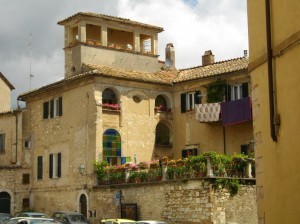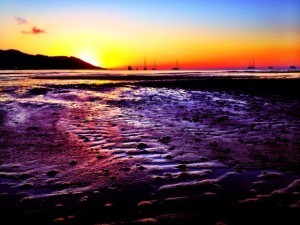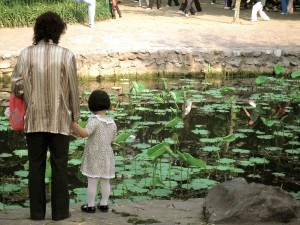Lisa Niver's Blog: We Said Go Travel, page 475
August 16, 2013
Cook Islands: Back to the Land
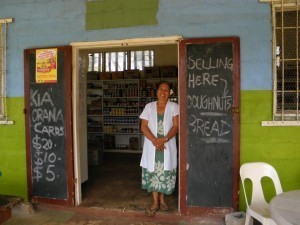 It’s 5 o’clock in the morning and I’m running through waist-high grass toward a pack of frenzied dogs. Their cacophonous barking drowns out the squeals of a wild pig, who’s preparing to pay a price for the crops he and his fellow swine have uprooted.
It’s 5 o’clock in the morning and I’m running through waist-high grass toward a pack of frenzied dogs. Their cacophonous barking drowns out the squeals of a wild pig, who’s preparing to pay a price for the crops he and his fellow swine have uprooted.
Sweat drips from my hairline and red mud streaks my bare arms. I’m fighting a slight hangover; it’s a reminder of the night before, a night I spent in a thatched-roof hut with the locals, drinking homebrew from coconut shells, singing to the plink of a ukulele and the rhythm of a twig tapping an overturned bucket.
I’m tired but I’m determined not to let my weakness show. My barefoot guide – a pious man who prayed over this journey before he picked up his machete and loosed his starving dogs– is challenging me to prove my great-grandmother’s blood does in fact course through my veins.
 I’m visiting her island, this place the locals call Enua Manu and the world calls Atiu. It is one of the 15 Cook Islands in the South Pacific – a Polynesian paradise that’s home to one school, a handful of general stores, and 500 of the world’s friendliest people. I’ve been here four days, and already this island has captured my heart.
I’m visiting her island, this place the locals call Enua Manu and the world calls Atiu. It is one of the 15 Cook Islands in the South Pacific – a Polynesian paradise that’s home to one school, a handful of general stores, and 500 of the world’s friendliest people. I’ve been here four days, and already this island has captured my heart.
“Hurry! You reckon you’re brave enough?!” my guide is yelling. He raises his eyebrows in a laugh, but he is not joking. I take the knife from him, inhale, and silence the pig.
When it’s over, I’m smiling. I know it’s macabre, but I can’t help it. I’m new to the concept of living off the land and it makes me feel grounded.
Yesterday, I stood on a shallow reef, up to my thighs in translucent sea, and fished for snapper using live crab as bait. Last night, we paired it with fresh taro and bananas plucked from a tree in the yard, and as the sun dipped low and we ate the fruits of our foraging, we were wordlessly saying the same thing: This is the life.
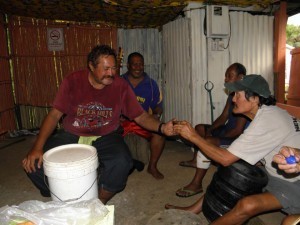 There is something about this island – the rugged masculinity of its caves and cliffs, the promise of adventure in its gnarled jungle, the self-sufficiency of its people – that has wiggled its way into my soul.
There is something about this island – the rugged masculinity of its caves and cliffs, the promise of adventure in its gnarled jungle, the self-sufficiency of its people – that has wiggled its way into my soul.
Its beauty is jagged in some places and postcard-worthy in others. Its17 square miles accommodate a drastically varying landscape – there is footprint-free white sand retreating into a glassy lagoon and there are frontiers of raised gray coral, sharp and forbidding and hot. There are vast swaths of swampland hosting taro plants green as candy, and there are quiet lakes lapping against a mysterious, prehistoric forest.
And then there are the caves, a subterranean labyrinth hiding the secrets of generations past and the ancestral bones of the Atiuan people. They are vast, full of intrigue, with banyan roots and birds coursing through their damp darkness.
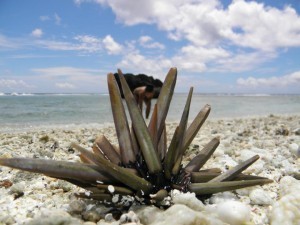 This island is at once peaceful and full of adventure. Here, I am free from the suffocation I sometimes feel in the tangle of city concrete, free from the anxiety I sometimes feel within the confines of my cubicle. Here, I am not bound by alarm clocks and Google Alerts and gridlock traffic; instead I am at the mercy of the phases of the moon and the swell of the sea and the creatures of the earth.
This island is at once peaceful and full of adventure. Here, I am free from the suffocation I sometimes feel in the tangle of city concrete, free from the anxiety I sometimes feel within the confines of my cubicle. Here, I am not bound by alarm clocks and Google Alerts and gridlock traffic; instead I am at the mercy of the phases of the moon and the swell of the sea and the creatures of the earth.
In a big and busy world, crowded and contaminated by people and pollution and politics, Atiu is an oasis, a place where I can be close to the land and the people who work it, a place where I am free.
About the Author: Rachel Michele Teana Reeves: I’m a reporter, columnist and freelance writer based in Los Angeles. I recently moved back to the U.S. from Rarotonga in the Cook Islands, where I wrote for a daily newspaper and a local travel magazine. I have an abiding love of travel that’s taken me through the Pacific, Asia, Europe, Mexico, and Aruba.
The post Cook Islands: Back to the Land appeared first on We Said Go Travel.
Montana, America: Cowgirl Yoga
Adventure and Peace in the American West
The Last Best Place
My first morning in Montana, I awoke to guttural, almost prehistoric, squawks outside my window. I bolted upright and slid my sleeping mask to my forehead. Our yoga teacher had closed our Vinyasa practice the night before with a warning: over-zealous songbirds often begin their chorus around four in the morning.
But it wasn’t a songbird I’d heard. It was a dinosaur.
“Those are the Sandhill Cranes,” our instructor said, as we unrolled our mats in the barn loft after breakfast and settled into Sukhasana, or easy seated pose. Two women staying in the cabins by the Shields River had sighted the slender grey birds with bright red foreheads and six-foot wingspans. Part of the Whooping Crane family, they have exceptionally long windpipes that can carry their primitive calls more than a mile.
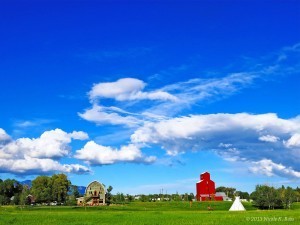 It turned out the Sandhill Cranes were just the first of many surprises that awaited me in The Last Best Place. We moved onto our hands and knees and began a series of Cat-Cows to get the blood flowing. That was about the time hail started pelting the barn windows. In June.
It turned out the Sandhill Cranes were just the first of many surprises that awaited me in The Last Best Place. We moved onto our hands and knees and began a series of Cat-Cows to get the blood flowing. That was about the time hail started pelting the barn windows. In June.
Going It Alone
For two years, I’d cyber-stalked Big Sky Yoga Retreats but never pulled the trigger. It was silly to spend all that money on just a few days. It probably wasn’t as fun as it looked. And the oldest excuse in the book: I didn’t want to go alone.
At 26, I’d suffered my first anxiety attack, and travel lost its appeal. I still traveled a lot over the next four years, but worry became the first thing I unpacked at my destination.
Travel was supposed to be fun. I still vaguely remembered the time when it was. There had to be someplace I could free myself from anxiety and reconnect with the childlike wonder of deliciously-selfish travel.
I mailed my deposit.
Not only didn’t I know anyone else going on the retreat, I didn’t know a soul in the entire state of Montana. And it’s a pretty big state.
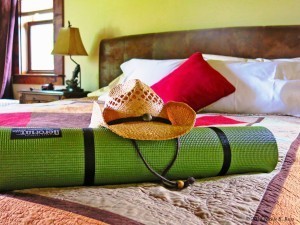 Cowgirl Yoga: The Best of Both Worlds
Cowgirl Yoga: The Best of Both Worlds
I grew up liking horses. Well, technically, I grew up infatuated with horses. I was at the barn weekly—if not daily. The rich smell of freshly-oiled leather, the gentle nickering of horses eager for breakfast, the velveteen muzzles—it was heaven on earth. But after college, riding faded to make way for a career, grad school, and ‘more important things.’
Yet, the ‘me in my mind’ still wore dusty, butter-soft cowboy boots. The ‘me in my mind’ still wore jean skirts and straw hats. The ‘me in my mind’ answered to no one but herself. She was independent, adventurous, brave. I feared that easy-going, horse-crazy cowgirl was gone for good.
But I had a hunch she’d been waiting for me in Montana all along.
Every morning, we enjoyed breakfast together before climbing the steps to the loft for yoga. Breathing deeply, we asked much of our bodies and received even more in return. We’d arrived broken, some in body and some in spirit, but somehow we healed each other. We’d arrived alone, but together our hearts were full. More than once, I found myself standing in Tadasana, gazing at the Crazy Mountains, giving thanks for that place, that time, and those women.
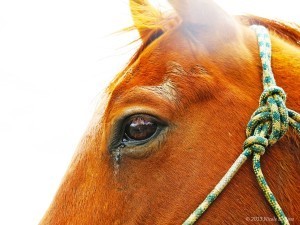 After lunch, we headed to the pasture. Each horse had a distinct color, size and shape, personality and history. But grazing in the field, they formed a breathtaking, complete unit. Just like us.
After lunch, we headed to the pasture. Each horse had a distinct color, size and shape, personality and history. But grazing in the field, they formed a breathtaking, complete unit. Just like us.
To each woman, her horse was the most beautiful. It was easy to see from the way the women looked into their soulful eyes, the way they stood on their tippy-toes and whispered into their flickering ears. Moments like these were why we had all come.
Moments like these were why we never wanted to leave.
Free to Be Me (Boots and All)
Four days later, as we relished our final meal together, I listened as women spoke about leaving careers and relationships that no longer served them. I listened as powerful, funny, inspiring women shared their hopes, fears, and dreams. We laughed together. We cried together. We were simply ourselves together.
In She Flies Without Wings, Mary D. Midkiff says, “The horse…carries us through the doors that stand between the familiar and the unfamiliar; limitations and freedom; and introduces us to experiences we might otherwise miss.”
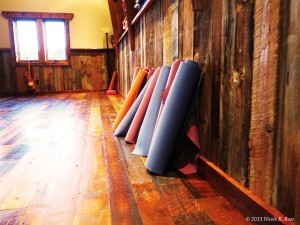 Finally, I’d been able to shed the oppressive weight of anxiety, responsibility, and practicality and traveled for me. For the first time in years, I felt truly…free.
Finally, I’d been able to shed the oppressive weight of anxiety, responsibility, and practicality and traveled for me. For the first time in years, I felt truly…free.
The snow-capped Crazy Mountains glinted to the East as I drove to the airport. A cool breeze drifted through the Subaru’s windows and tousled my hair. I had a smile on my face, peace in my heart, and vowed to return.
About the Author: Nicole K. Ross is an Indianapolis-based writer & perpetual explorer. Her insatiable curiosity has spurred travel to more than 15 countries and made her equally at home on the back of a horse, inside the boxing ring, pounding away at her keyboard, and perched in downward dog atop her yoga mat. Find her on Facebook.
Learn more at
The post Montana, America: Cowgirl Yoga appeared first on We Said Go Travel.
Nicobar and Andaman Islands: Ship, Sea and the Sun
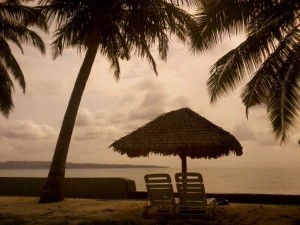 Ship, Sea and the Sun: a wobble down the corridor
Ship, Sea and the Sun: a wobble down the corridorIt was the month of May, I still remember it as clear as the sea that I am glazing at right now; yes, I had been to this place before, the setting sun, the waves crashing on the moss covered rocks and the smell of fried fish, It is one of those places that I could never forget.
Since childhood I grew up reading stories about islands, pirates and sea and wished for getting stranded on one through it might sounds childish but after reading Robinson Crusoe and Treasure Island, it was what I always fantasised about , it had become one of my lifelong dream to just escape into the vast ocean and live a life of adventure.
Situated to north of Aceh in Indonesia and separated from Thailand and Burma by the Andaman Sea, The Andaman and Nicobar Islands are a group of islands at the juncture of the Bay of Bengal and Andaman Sea, and are a Union Territory of India.
With a rich historical background, the island itself speaks of its past like an ancient book revealing the mysteries and the myth it has hidden among the folds of papyrus, from the pre-colonial era to the terrifying times of world war II the island holds a history of colonisation, struggle, war and freedom. After the independence of India in 1947, the Andaman and Nicobar islands became a part of the Indian union in 1950 and was declared a union territory in 1956.
I remember the first time I visited the islands, it was the month of May and I had just finished my annual exams and was on a family vacation to the islands as a part of the escape plan my parents had decided for me ,being a kid adventure was my first priority so when my parents asked for my opinion on the choice of our travel medium, since there were only two ways of reaching the islands and it was either Ship or Plane ,I immediately jumped on the idea of travelling by sea route and it was decided ; but the minor fact that I missed was that it would be a 4 day long journey in a vessel surrounded by ocean with an occasional feeling of sea sickness .It was my 2nd day and I was still inside the cabin lying on my bed green as a cucumber looking at the ceiling wondering when this torture would be over, since the day I stepped on board I hadn’t been able to get up and move a few feet without feeling a pang of sea sickness and the irony was that I couldn’t even complain since it was my idea after all.
By the 3rd day I somehow got used to the feeling (with the doses of sea sickness tablets of course) and decided to explore the deck. Getting out of my safe haven I wobbled down the corridor to see the surrounding islands and ocean but what I saw was far more beautiful than I had expected, like green emeralds in the ocean, the islands looked like small gems glittering in the summer sun, the smell of salt and sea with a touch of breeze were a relief to my soul.
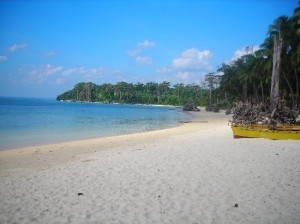 On 4th day we reached Port Blair, the Territory’s capital and started to explore. The islands are a beauty and blessing of Mother Nature itself in the disguise of a unique rainforest with mixed elements of flora. There are various tourists’ spots on the islands starting from the cellular jail to Ross Islands to the beautiful beaches of Havelock islands, all places are something you don’t want to miss. Speaking of a place not to be missed is Coral islands, where you get the chance to explore and see the corals, all you need to do is get a guide, take a dip and enjoy the beauty your eyes would love to see again and again. But the place that got me rooted was the beautiful beaches of Havelock Islands and the mouth watering varieties of sea food from fishes to crabs to prawns, everything is at your service like a never ending tale of sea foods.
On 4th day we reached Port Blair, the Territory’s capital and started to explore. The islands are a beauty and blessing of Mother Nature itself in the disguise of a unique rainforest with mixed elements of flora. There are various tourists’ spots on the islands starting from the cellular jail to Ross Islands to the beautiful beaches of Havelock islands, all places are something you don’t want to miss. Speaking of a place not to be missed is Coral islands, where you get the chance to explore and see the corals, all you need to do is get a guide, take a dip and enjoy the beauty your eyes would love to see again and again. But the place that got me rooted was the beautiful beaches of Havelock Islands and the mouth watering varieties of sea food from fishes to crabs to prawns, everything is at your service like a never ending tale of sea foods.
And now as the sun sets in the horizon I am back at the beach as the waves wash my feet from the fine grains of sands, taking away my worries and tiredness as I look for a sign of my childhood but this time it is the month of June and I am back on the islands again after the tsunami, alone and young but with a sense of contentment, with the sounds of the waves I look at the memories I have gathered at this island, the joys of childhood and an escape from reality, this is my place of independence, the islands of freedom.
About the Author – Ritika Sagar: I am an English Literature student going to start my 2nd year and on the lookout for my next adventure at another place and in another country soon.In my free time I am a writer working on long projects and exploring my options or watching movies and enjoying my life. Find me on Facebook.
The post Nicobar and Andaman Islands: Ship, Sea and the Sun appeared first on We Said Go Travel.
Nigeria: The Ruin at Old Oyo National Park
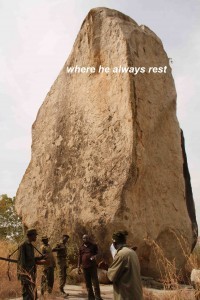 Nigeria: A visit to the Ruin at Old Oyo National Park
Nigeria: A visit to the Ruin at Old Oyo National Park
Ever since I was born, I’m always thrilled with culture especially the culture I was born into (the Yoruba culture). I love the moon light stories of long past warriors; those that have made their footprints in the sand of time. Invariably, travelling and excursion are what I find delight in.
I remembered one moonlight night when my father told me about one of the prominent past Alaafins (King of the Oyo Kingdom), Sango who was the third king of the Oyo Kingdom. His symbol is a double-headed axe, which represents swift and balanced justice. He is the owner of Bata (double-headed drums), as well as the Arts of Music, Dance and Entertainment in the Yoruba Culture. This powerful King is not only seeing as a God by the Yorubas but by other tribes in other countries especially in the Caribbean. Sango is celebrated in Haiti, as a god of thunder and weather; in Brazil, he is known as Xangô; in Umbanda, as the very powerful Nago Shango; in Trinidad as Shango god of Thunder, drumming and dance ; and in Cuba, Puerto Rico and Venezuela – the Santeria equivalent of St. Barbara, he is known as Changó.
Stories about Sango’s life exemplify some major themes regarding the nature of character and destiny. Stories about Yoruba sometimes may bring confusion due to lack of uniformity. A typical example is that of the origin of the race. This is due to lack of documentation as often times this stories are pass down from generation to generation by word of mouth. In a set of stories, Sango is the son of Aganju and Obatala. As the story goes, Obatala, the king of the white cloth wanted to cross a river when travelling, which Agaju the ferryman and god of fire refused him passage. It was said that Obatala retreated and changed to a beautiful woman. The beautiful woman returned to the river and seduced Agaju who later allowed her to cross over the river. The result of the uneasy union between Agaju and the beautiful woman (Obatala) was Sango. Sango went in search of Aganju, his father, and the two of them play out a drama of conflict and resolution that made Sango threw himself into the fire to prove his lineage.
Sango had three wives; Oshun, (a river goddess) was his favorite because of her excellent cooking and she is celebrated in Nigeria every year in Osun State of Nigeria: a celebration that is recognized by United Nation Education and Scientific Organization (UNESCO), Oba (another river goddess) offered Sango her ear to eat. He scorned her and she became the Oba River, which merges with the Oshun River to form dangerous rapids. Lastly, Oya (Sango’s third wife) was a crafty woman who stole the secret of Sango’s powerful magic.
Oba was Sango’s first and legitimate wife, Oshun; his second wife, and Oya; his third wife, whom he made his queen. Oshun played a trick on Oba, out of jealousy. She deceived Oba that if she can cut a piece of her ear and offer it to Sango as part of his meal, he would love her the more. Oba, excited by this information, ran home to prepare Shango’s “amala”, his favorite meal. She sliced off her ear and stirred it into Sango’s food. While Sango was eating, he saw the ear in the food and was infuriated thinking that Oba was trying to poison him. Sango drove her from his house and Oba ran out crying. She fell to the ground and turned into a river which is still being worshipped till date. She became the patron of matrimony (as “Orisha”) and it is believed that she destroys marriages that abuse either partner.
Historically, Sango brought prosperity to the Oyo Empire during his reign. He is associated with the sacred animal, the ram, and the colors of red and white. Sango displayed his magical powers by directing lightning unto his own household killing his wives and children. He hung himself after the incidence; he was deified as the god of thunder and lightning.
This story which thrills me the most made me follows a research team called the Africa Mystery Researchers (Aditu) who are into mysteries happening in the world to see for myself where Sango really resided and the ruins of the Old Oyo Kingdom. What I found excited me. I couldn’t believe what I saw and other stories I was told which if I try to start narrate will take up to one year to finish. Lo and behold I felt so free and relax. Looking forward to another one.
About the Author:  is a 500 level Law Student at University of Ilorin, Nigeria. Find him on Facebook.
is a 500 level Law Student at University of Ilorin, Nigeria. Find him on Facebook.
Twitter @yakwtd
The post Nigeria: The Ruin at Old Oyo National Park appeared first on We Said Go Travel.
August 15, 2013
Italy Re-Mastered
I always forget my camera. ‘How will you remember?’ My mother asks, brow furrowed. My response: ‘If I forget something, then it wasn’t that important.’ A philosophy that has not always worked out. So, on my trip to Italy, I was determined to record everything. Not only to save my memory but my life –my mother might bite off my head if I came back from our ancestor’s birthplace with only a few souvenirs as evidence. Italy, prepare to be digitally re-mastered.
Spiraling up the narrow streets of Old Amelia, my every idealistic dream of Italy is fulfilled; I would have been disappointed if I hadn’t seen homes with ivy crawling down their walls or a clotheslines waving in the sun. I had only been in Amelia a week, and the town’s historical feel and flourishing countryside had siren called my friend Bailey and I. As we photo raided the old town, our descriptions were all the same. With the crumbling stone streets and flowers blooming from every crack and balcony, it was the perfect setting for Romeo and Juliet. With the expanse of forest stretching to forever, I immediately blurt out Fangorn. With side paths leading to hidden caves, we understood how Fairy Tales crept into the minds of men.
My mind felt muddled. I was uncertain whether the magic quality I was so sure I sensed hanging in the air amidst the countryside was authentic, or merely stemming from my own expectations of Italy. I expected charming villas and houses impossibly gripping hillsides. But my mind only saw how the real Italy fit into my own created version. I refused to compare Italy to anyplace I had seen in the United States –Italy was mythical. Legendary. Unattainable perfection. Fairy tales and Lord of the Rings comparisons uplifted Italy onto a pedestal of fantastical proportions. As soon as Italy resembled the United States, its magic would die.
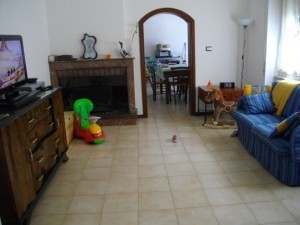 I desired Italy’s old-school charm, but it isn’t a country of stone cottages with people baking their own bread. My host family had a washing machine, internet, and televisions in just about every room. Nevertheless, I took the majority of pictures in Old Amelia, the stereotyped ancient Italy. Not only was I perpetuating the illusion of idyllic Italy for myself, but for everyone who would see my pictures. I was trying to force Italy into my narrow vision instead of letting Italy show itself to me, resisting Italy’s introduction to a more modern age. Americans want the tourist Italy displayed in movies, but Italy needs modernization to survive. A difficult dichotomy for Italy to juggle. How can it prosper if the marketplace is holding it back? How can it satisfy the world if we are demanding it to maintain its traditions, but throw a fit if there is no Wi-Fi?
I desired Italy’s old-school charm, but it isn’t a country of stone cottages with people baking their own bread. My host family had a washing machine, internet, and televisions in just about every room. Nevertheless, I took the majority of pictures in Old Amelia, the stereotyped ancient Italy. Not only was I perpetuating the illusion of idyllic Italy for myself, but for everyone who would see my pictures. I was trying to force Italy into my narrow vision instead of letting Italy show itself to me, resisting Italy’s introduction to a more modern age. Americans want the tourist Italy displayed in movies, but Italy needs modernization to survive. A difficult dichotomy for Italy to juggle. How can it prosper if the marketplace is holding it back? How can it satisfy the world if we are demanding it to maintain its traditions, but throw a fit if there is no Wi-Fi?
Yet it would be impossible for Italy to live up to my idyllic standard, since Americans cannot decide what we want.
On the golden bridge in Florence, in Titignano exploring vineyards, in Assisi experiencing the spirituality of the church, all the students, even I said –‘Just wait until Rome.’ We were in places full of history, culture, and beauty. Yet it wasn’t enough. Italy wasn’t Italian enough for us. We were looking forward to the bigger, the better. Even my host mother contributed to Italy’s inability to compete with itself as she said to me over a handmade pasta dinner, ‘Florence is beautiful, Assisi great, but Rome is best.’
Could even Rome fulfill the ideals I had built? Or was it only where I would collect the best pictures, ones untouched by the modern age? Temples, the pantheon, Colosseum. Perfect for my photo presentation to my family to show the magnificence of Italy. However, moments where pictures were impossible, or not impressive enough to earn a place in my slideshow, captured a spirit of Italy photos failed to illuminate. When my host mother translated the News for me every night, laughing at the ridiculous politicians. When I was waiting to see the David, but was more interested in watching the man who sold pictures on the streets, run from the cops.
Maybe it’s serendipitous I sometimes forget my camera. Behind the camera I control what I see and show others. Leaving the camera behind allows Italy to show itself to me without my own stereotypes staining my photos and memory. Italy is a mix of history and art and myths, but we often forget the authentic Italy, the common people who actually live there. Americans need to accept Italy as it is, or is trying to be, and not foolishly like me decide to try and preserve a culture we think we understand. We cannot prevent Italy from progressing and flourishing in its own way –mastering its own life.
About the Author: I’m Lindsey Fischer and I am going into my junior year at Allegheny College, as an English major, and History and Latin double minor. Originally I am from Ohio, where all the members of the Italian side of my family live, and eat, and talk and talk…I love reading writing, swing dancing, and now, travelling!
The post Italy Re-Mastered appeared first on We Said Go Travel.
Australia: Fishing for Zen
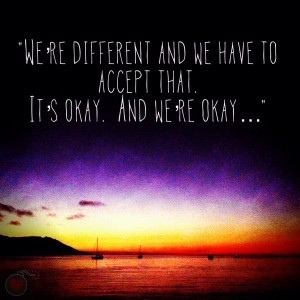 Although we didn’t have much light left because of the late start, the views were incredible and the company was great. A 15 minute barefoot walk had taken us out to the other side of the bay and our agenda for the night was simple: sunset fishing and beers.
Although we didn’t have much light left because of the late start, the views were incredible and the company was great. A 15 minute barefoot walk had taken us out to the other side of the bay and our agenda for the night was simple: sunset fishing and beers.
Clamouring over a series of large boulders, Ty and I found an isolated spot, baited our hooks, and settled in to do some fishing. I don’t do it nearly enough but fishing contains easy going multitudes, and easy going multitudes are something I always enjoy.
I was happy to be with Ty. He appreciates the little things in life, understands the true essence of rarity and wears his kind heart on his sleeve. I once joked with Ty that he’s a modern day version of Huckleberry Finn, and that I was going to make him a shirt that said simply, “WWHFD?”
He liked that idea a lot.
“More people should do this,” I told Ty, taking a sip from my beer and staring out into the ocean.
“Fishing?”
I shook my head.
”Life.”
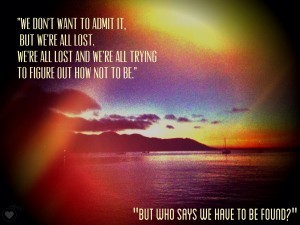 He nodded in agreement. ”Yeah, man, but some people are just lost.”
He nodded in agreement. ”Yeah, man, but some people are just lost.”
I took a moment to respond, “We don’t want to admit it, but we’re all lost. We’re all lost and we’re all trying to figure out how not to be.”
And then, much to my pleasant surprise, Ty fired back.
“But who says we have to be found?”
He smiled and looked my way.
“Touché, my friend.”
We were out fishing but really, that wasn’t the point. Deep down, we both knew that we weren’t going to catch anything that night – there was simply no way. For one, we lacked preparation, foresight and skill. For two, we had no idea if there were any fish in this part of the bay as neither of us had ever been there. For three, we were drinking and forgetting that we were actually fishing at all – at least I was. Consequently, I’d catch myself staring at the stars rather than noticing that my hook no longer had any bait.
But I was alright with that.
There are worse things to be lost in than a bit of light amidst the darkness.
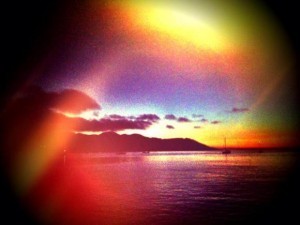 After a few moments of silence, Ty jumped in. ”My dad thinks I’m wasting my life living on this island.” He looked out across the bay as the light slowly died, the colours were in mourning.
After a few moments of silence, Ty jumped in. ”My dad thinks I’m wasting my life living on this island.” He looked out across the bay as the light slowly died, the colours were in mourning.
“Yeah, mine doesn’t necessarily understand me either, man. He doesn’t get why I’m not killing myself to buy a house, to own a car, to climb the social ladder. Imagine inviting them tonight. ‘Hey Dad, do you want to go somewhere you’ve never been and go fishing and climb over big, slippery rocks in the dark?’ It’s doubtful, my friend…”
Everything was silent.
Ty was next to me, but he was far away as well, lost in conversations past and wrapped up inside the pain of days gone by. As if to answer the questions swirling around inside his own head, he whispered, “We’re different and we have to accept that. It’s okay. And we’re okay…”
About the Author: Jeremy Goldberg: I make big things small, small things visible, and visible things known. But mainly, I’m trying to make the world better than it was yesterday. Currently in Australia. Connect with me here:
The post Australia: Fishing for Zen appeared first on We Said Go Travel.
Iran: B.O and Bad Breath
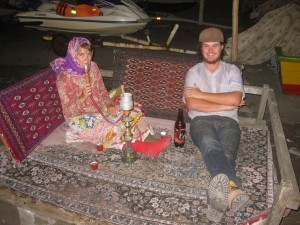 As the fourteenth country of the forty three that we would visit on our drive from Australia to Scotland, Iran was exciting and new; experiencing so many different ways of life in such a short period of time though we were becoming very used to adapting to cultural habits that we would usually find uncomfortable and social norms that ordinarily we would consider wrong or rude. Having already been in Iran for a couple of weeks I was becoming somewhat used to the ordeal of covering myself from head to toe, despite the dry summer heat, but on arrival in Tehran I wasn’t quite prepared for a ride on the metro.
As the fourteenth country of the forty three that we would visit on our drive from Australia to Scotland, Iran was exciting and new; experiencing so many different ways of life in such a short period of time though we were becoming very used to adapting to cultural habits that we would usually find uncomfortable and social norms that ordinarily we would consider wrong or rude. Having already been in Iran for a couple of weeks I was becoming somewhat used to the ordeal of covering myself from head to toe, despite the dry summer heat, but on arrival in Tehran I wasn’t quite prepared for a ride on the metro.
There were women’s only carriages and uni-sex carriages on every train, as would be expected. Most women travelled on the women’s carriage, but there were always a few travelling with the men for whatever reason. For ease of navigation, and of course just for the sake of company, I chose to board with my male companions and ride the uni-sex carriage on our first metro outing.
After we squeezed on to the already packed train, another hoard of travellers forced themselves on. The density of people traffic on the Tehran metro is certainly not something that can be compared to anywhere ever in Australia, but having previously caught public transport in Paris, Shanghai, Bangkok and plenty of other world renowned busy cities, I can honestly say I’ve never seen anything like this. I was lifted from the ground by the force of the crowd and breathing through the stench of BO, breath and aftershave was certainly a feat.
At one station the wave of bodies jostled and swayed and I realised that a man whose face I couldn’t see because of the other men standing between us and the fact that my head was awkwardly squashed to be facing the other way, had his arm which had been tangled up in the throng and wrapped around some other torsos, strategically resting on my body about 10cm below my chin. Unable to reposition myself in the slightest there wasn’t much I could do about it, so for the few minutes until the next station I stood there with this stranger’s hand conveniently cupping my body part until the train halted at the next stop. The crush of bodies violently surged as the carriage doors opened and the hand was washed away along with the bodies which had surrounded me, only to be replaced by a new rush of commuters. I decided to give the women’s carriage a go on our next trip.
The women weren’t quite as smelly or as pushy and there was marginally more space. Where the men’s carriage had felt cold and faceless, the women’s carriage had an air of frivolity and liberty about it. They were all very jovial with each other; it felt as if the whole carriage was occupied by one group that was travelling together. I was still stared at, but more out of interest than disdain – at least that’s what I’m happy to believe. I really enjoyed the sense of community and freedom that I saw in these women, the single sex train carriage being their sanctuary. I never travelled with the men on the train again.
About the Author: Eilidh Robertson: Originally from Scotland I now live in Australia, and amidst a variety of jobs my adult life thus far has revolved around travelling. I’m doing my best to experience the untouched corners of the world as much as possible and my most recent trip was an overland roadtrip by car from Australia to Scotland. Find me on Facebook or check out my blog.
The post Iran: B.O and Bad Breath appeared first on We Said Go Travel.
China: Lost in Lu Xun Park
If I had been asked to paint Independence as a nineteen-year-old college sophomore, the resulting red-white-and-blue canvas would likely have featured George Washington riding a bald eagle with the US Constitution clutched in its talons. By that time, I naively fancied myself well-versed on the subject – I had been in college for two years, cooking my own meals, doing my own laundry, and in general being an Independent Woman. As a patriotic southern American, therefore, I was mildly surprised when I learned to redefine freedom on the other side of the globe, in the People’s Republic of China.
Let me back up. This isn’t a story about how I learned how to stand on my own two feet in a far-off land. This is a love story about running.
Though my school-sponsored study abroad trip to China did mark my first steps on international soil, the mere act of living abroad was not liberating in and of itself. The program, a study on globalization, was a strictly scheduled tour of China’s great monuments, interspersed with some economic and political coursework. For three weeks, I was shepherded through every Chinese landmark I’d ever heard of. I traipsed through the Forbidden City, climbed the Great Wall, and rose 1300 feet in the Jin Mao tower. These monuments, while grand and impressive in their spectacle, never took me out of my comfort zone. I trekked through each with my American university group, seeing only what I was instructed to see.
I have jetlag to blame or thank for my discovery of Lu Xun park, in the Hongkou district of Shanghai. I had no interest in exploring the area around our hotel, but 24 hours of travel had left me wired and restless at 6 AM on my first morning in China. I pulled on my tennis shoes, plugged in my headphones, and headed out. Three miles later, I first entertained the thought that I hadn’t been keeping track, couldn’t read the street signs, and had no clue where I was. What was worse, I didn’t quite mind.
I ran down side alleys and through crowded fish markets. I ran around Tai Chi classes in the park’s dewy lawn and past old men smoking under crooked trees. Somewhere in my morning lay a valuable lesson about the danger of a teenage girl getting lost alone in a city where she didn’t speak the language, but I must have missed it. When I finally made my way back to my hotel an hour later, I’d already planned to add solo morning jogs to my daily routine. My constant movement and the thickening crowds gave me anonymity and opportunity to just observe, without expectation or agenda. In a city where every site clamors for superlatives – biggest, tallest, densest, newest – Lu Xun park was beautifully ordinary. Even in the pale dawn, this perfectly average plot of urban greenery already brimmed with thousands of unique, emotional, intricate narratives.
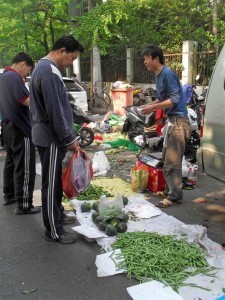 It’s a false and tempting cliché to assume that my daily runs through Hongkou showed me the “real” China, but the tanned and thrifty salesmen selling tomatoes in Jiangwan Road weren’t any more authentic than the tourist merchants at the Great Wall. In contrast, these slow and solitary jogs taught me that vibrant reality bursts from every common corner of the world. Running showed me how to imagine individuals complexly, beyond the role they play in my own life.
It’s a false and tempting cliché to assume that my daily runs through Hongkou showed me the “real” China, but the tanned and thrifty salesmen selling tomatoes in Jiangwan Road weren’t any more authentic than the tourist merchants at the Great Wall. In contrast, these slow and solitary jogs taught me that vibrant reality bursts from every common corner of the world. Running showed me how to imagine individuals complexly, beyond the role they play in my own life.
To this day, whether I’m lost in a foreign continent among 23 million strangers or trotting around the neighborhood where I was born, I can always find solace in the steady bass line of my feet hitting the pavement. I am free to chart my own path, but the detours and quick decisions along the way usually provide the most memorable stories. I no longer need to travel long distances to find the extraordinary in the everyday, but I first discovered that skill on a soft May morning, lost in Lu Xun park.
About the Author: Brooke Watson is a 21-year-old former athlete, future doctor, and present gypsy. She’s been to China and Cape Town, and is currently planning a year-long Antipodean adventure in New Zealand and Australia. Sometimes she takes pictures .
The post China: Lost in Lu Xun Park appeared first on We Said Go Travel.
August 14, 2013
Myanmar: Day of Ceremonies and Thanaka, Bagan Day Five (video)
WATCH: 29 Day of Ceremonies and Thanaka, Bagan Day Five, Myanmar (Burma)
October 15, 2012 On this Sabbath day, we biked in the heat to Sulemani and there was a monk leading a service. Seeing the site being used for a ceremony was like having history come alive. At Maha Bodhi Pagoda, an Indian style temple, there are the seven weeks of Buddha’s enlightenment. Both George and I got styled up with Thanaka, “for beauty and protection.”
For lunch we ate at “Be Kind to Animals” We enjoyed the traditional Tea Leaf Salad, Pumpkin Curry, Myanmar Tomato Curry, with rice, water, peanuts to start and tamarind flake candy to finish it was less than 7000K. They also had many juices like tamarind and mint but it the high heat we needed water.
We went back to Shwe Gu Gyi: which is one of the temples you can climb up. Quite a few do not allow it anymore. We had a bit of rain, great views, and were ready to view more temples. At Upalithein: it was all locked up but had great paintings. On the way back to town, we saw Hilo Milo and stopped for another sunset visit to Shwe Zigon Zedi.
At Shwe Zigon Zedi, the golden temple, I rung the bells for my birthday, and George made the birds fly away. For 1000K we each added Gold Leaf to the Buddha. It was a full day from 9:30am to 5:30pm of biking in the heat, a long hot sweaty day of seeing great sites and ceremonies!
This movie is from our 28 days in Myanmar (Burma) from September 28, 2012 to October 26, 2012 and our year TRIP in South East Asia, see all the videos from our trip.
Buy our memoir, Traveling in Sin, at Amazon; it is a HOT NEW RELEASE!
Traveling in Sin is a TOP TEN Hot New Release! from Lisa Niver Rajna
The post Myanmar: Day of Ceremonies and Thanaka, Bagan Day Five (video) appeared first on We Said Go Travel.
Brazil: I Heart Bahia
 It was New Year’s Eve. The stems of wilted, white and golden roses washed up on the shore and tickled my feet, offerings for Yemaya (the Sea Goddess) from the people of Salvador, Bahia. Everyone was dressed in white. I watched as people threw themselves into the Ocean, some fully clothed. A pulsating Spirit permeated in the air…there was a sense of laughter and joy. I smiled, bemused that, in this moment, I was free. I was amongst these Children of the Sea.
It was New Year’s Eve. The stems of wilted, white and golden roses washed up on the shore and tickled my feet, offerings for Yemaya (the Sea Goddess) from the people of Salvador, Bahia. Everyone was dressed in white. I watched as people threw themselves into the Ocean, some fully clothed. A pulsating Spirit permeated in the air…there was a sense of laughter and joy. I smiled, bemused that, in this moment, I was free. I was amongst these Children of the Sea.
I was standing at the shore holding hands with a Brazilian girl as she explained to me in careful Portuguese how to cleanse oneself of the past and “bring in the new.” She instructed me to jump over each wave seven times and afterwards, ask Yemaya for 3 wishes to be granted. After leaping together, I stood stark still whilst gazing out into the vast unknown that is the Atlantic Ocean. I inhaled deeply and took in my surroundings. Wow, I thought. I am in Brazil. It seems that Yemaya has already granted at least one of my wishes.
It all started three months earlier, after a particularly uneventful gig with my band, on a chilly New York autumn night. My mom and friends took me to dinner at a Brazilian restaurant named “Berimbau” and, upon entering, my entire body caught fire as I was instantaneously flushed and overwhelmed with nostalgia. I had visited Bahia, Brazil 4 years before that day to celebrate my 30th birthday, and I had loved it. But, I was startled by this visceral whole-body, whole-soul reaction.
Suddenly and seemingly out of nowhere, I began a lively discussion at the dinner table. “Why am I always doing what’s expected of me?” I asked no one in particular. “Why can’t I be the one to go and trek through some foreign country? Why do I need a ‘reason’ to do it?”
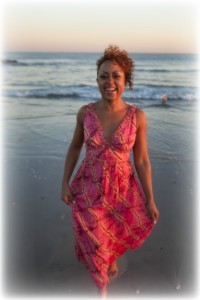 As these questions pervaded my mind, I had a rare momentary lapse in which my defenses were disabled just long enough to download a single idea: return to Bahia. So, after consulting with friends, family, colleagues and loved ones, the decision was made. I would sell and give away half of my belongings, put the other half in storage and I would move to Brazil for 3 months.
As these questions pervaded my mind, I had a rare momentary lapse in which my defenses were disabled just long enough to download a single idea: return to Bahia. So, after consulting with friends, family, colleagues and loved ones, the decision was made. I would sell and give away half of my belongings, put the other half in storage and I would move to Brazil for 3 months.
I had no idea what was waiting for me in Brazil. I didn’t know why I was going. All I knew was that once the idea made its way into my head, there was no getting rid of it. So, I moved forward with the necessary preparations and began the process of taking this extraordinary step. I didn’t even know where to start. How do you even pack for three months? I had never traveled anywhere for more than two weeks!
I began with the basics: I called, e-mailed and Facebook-ed every soul I had ever heard even remotely mention Bahia. I began Skyping with a language teacher to get my Portuguese game up. I got the necessary vaccinations. I called up a highly intelligent, straight forward, highly pragmatic friend and commanded him to drill me with practical questions and astute observations, hoping he would convince me that my plan is insane so I could abandon this absurd mission.
Of course, my ego (who does its job of maintaining the status quo quite well) berated me and tried to trick me into coming up with a tight-knit schedule to create a sense of “structure,” thus insuring some semblance of safety. I resisted and remembered a quote I read once: “a bad day for the ego is a good day for the soul.”
As the day of my departure grew closer, I grew anxious. I vacillated wildly between uncertainty and absolute sureness. I felt like a crazed lunatic, my head spinning at break neck speed on a mental roller coaster of my own making.
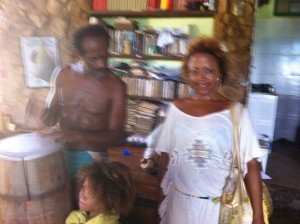 It was time to choose between a predictable and sturdy existence or the world of uncertainty that would surely be the result of heeding my soul’s call for revolution. Evolution. So, I chose.
It was time to choose between a predictable and sturdy existence or the world of uncertainty that would surely be the result of heeding my soul’s call for revolution. Evolution. So, I chose.
On a clear and cold December night, I flew into skies that didn’t feel too friendly at all. I gazed lovingly at the New York City skyline through the tiny window of the plane as a smiling crescent moon followed my ascent into the unknown, seemingly laughing at me. I silently wept, thinking, “What on Earth am I doing?”
About the Author: Stacie Aamon Yeldell is a Board Certified Music Therapist and an International Recording Artist. She currently resides in Venice, CA and travels frequently to Brazil. Visit www.stacieaamon.com and www.facebook.com/stacieaamon for more information.
The post Brazil: I Heart Bahia appeared first on We Said Go Travel.
We Said Go Travel
We Said Go Travel is a global community of over sixteen hundred writers with articles from every continent.
Stories are shared with photos and video from a perspective of the transformative power of travel. We Said Go Travel has hosted live and online events as well as travel writing contests around the world. ...more
- Lisa Niver's profile
- 57 followers



